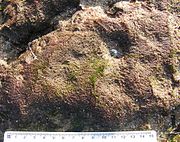| Rhodothamniella | |
|---|---|
| Scientific classification | |
| Clade: | Archaeplastida |
| Division: | Rhodophyta |
| Class: | Florideophyceae |
| Order: | Palmariales |
| Family: | Rhodothamniellaceae |
| Genus: | Rhodothamniella Feldmann |
| Species: | R. floridula |
| Binomial name | |
| Rhodothamniella floridula (Dillwyn) Feldmann | |
| Synonyms | |
| |
Rhodothamniella floridula is a small red seaweed detectable more easily with the feet than with the eyes. [1] It thrives only where sand and rock occur together: anchored to the rock, it accumulates sand to form a slightly soft irregular carpet a centimetre or so in thickness. Although the surface is a dull red colour, in cross section the appearance is of a miniature sand dune with no visible algal component. Unable to stand significant desiccation, it prefers locations from the mid-shore downwards.
It is to be found on most suitable shorelines around Britain and northern Europe. [2]

